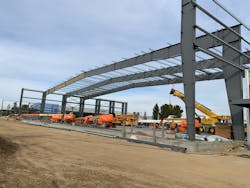Airport Development 101: Will an Investment be Profitable?
“If you build it, they will come.” Made famous by the classic 1989 film Field of Dreams, this popular business mantra implies that if you make the investment to build something, people will be drawn to use it. However, such advice can prove disastrous in real-life business situations, including development projects at our nation’s general aviation airports.
To protect an airport’s long-term economic health, public and private investors must resist the urge to develop new hangar, terminal and building space simply because the property is available. Rather, the feasibility and financial viability of future development projects must be determined by construction market research examining both customer demand and return on investment.
For example, a feasibility study is a type of market research which analyzes the potential success of a new business location or expansion to a new market. Commercial lenders often require a feasibility study to acquire financing for a project in order to eliminate risk of the investment. This analysis takes into account economic, technical, demographic and legal factors, as well as the competition.
As a starting point, the feasibility study should include a demographic and trend analysis, which helps to understand the potential size and profiles of clients/customers in a particular market area. A second core component is an overview of key competitors in the market — reviewing strengths, weaknesses, service offerings, differentiators and other factors that would impact the success or failure of a new market entrant.
Finally, a third important component of the feasibility analysis is a market study that determines interest in the location, appeal, demand and other objectives that may impact the viability of the proposed concept. Taking the time to conduct this research prior to investing in a new airport development can help secure investments, uncover gaps in the market, identify potential obstacles and determine if the project is worth pursuing.
General aviation airports also face the challenge of designing projects that maximize economic potential, while balancing the needs of community stakeholders. This often results in diverse aeronautical and non-aeronautical land uses, ranging from executive jet terminals and propeller aircraft parks to educational institutions and technology and innovation centers.
According to the Federal Aviation Administration (FAA), airport planning is a systematic process used to establish guidelines for the efficient development of airports that is consistent with local, state and national goals. A key objective is to assure the effective use of airport resources in order to satisfy aviation demand in a financially feasible manner. For an individual airport, the airport master plan represents its blueprint for long-term development. The goals of an airport master plan include:
- To provide a graphic representation of existing airport features, future airport development and anticipated land use
- To establish a realistic schedule for implementation of the proposed development
- To identify a realistic financial plan to support the development
- To validate the plan technically and procedurally through investigation of concepts and alternatives on technical, economic and environmental grounds
- To prepare and present a plan to the public that adequately addresses all relevant issues and satisfies local, state and federal regulations
- To establish a framework for a continuous planning process
Typically, an airport master plan should be updated every five to seven years. However, many airports are guided by master plans that were published 10 to 15 years ago — limiting their ability to respond to changing economic and market conditions. These master plans must be regularly updated to allow for new commercial development and redevelopment strategies aimed at maximizing property return and long-term financial stability, while improving environmental sustainability and meeting the needs of the community.
It is important to consider that, per the provisions of FAR Part 77, the FAA may require a civil airport to establish restrictions on the heights of buildings, antennas, trees, signs and other objects near its runways to protect the safe and efficient use of navigable airspace. In many cases, airport sponsors are challenged with mitigating the negative impacts of Part 77 while preserving vital economic and community benefits. Airport sponsors, tenants and stakeholders must work in collaboration with the FAA on solutions that balance airport optimization against coinciding urban encroachment.
Historically, local governments own and operate public-use airports, and receive federal funding for capital construction and maintenance projects. However, they are responsible for finding other sources of revenue in order to be self-sufficient. Because government sources of financing have remained at relatively the same level, private companies are paying for new types of improvements and services at increased levels. These public-private partnerships create new possibilities for airports to complete capital projects that improve facilities, offerings and amenities.
Within the framework of the master plan, airport sponsors must implement creative and strategic commercial development strategies that encourage substantial investment, reap significant return and attract diverse aeronautical and non-aeronautical land uses.
Curt Castagna, president and CEO of Aeroplex/Aerolease Group, is a member of the Los Angeles County Airport Commission, president of the Van Nuys and Long Beach airport associations, and board chair of the National Air Transportation Association. A certified private and instrument-rated pilot, he has instructed courses in aviation administration at Cal State Los Angeles for over two decades.
About the Author

Curt Castagna
President and CEO
Curt Castagna, President/CEO of Ascension Group Partners, serves as president and CEO of the National Air Transportation Association, member and past chair of the Los Angeles County Airport Commission, and president of the Van Nuys and Long Beach airport associations. A certified private, seaplane and instrument-rated pilot, he continues to instruct courses in aviation administration at Cypress Community College and Cal State Los Angeles.
